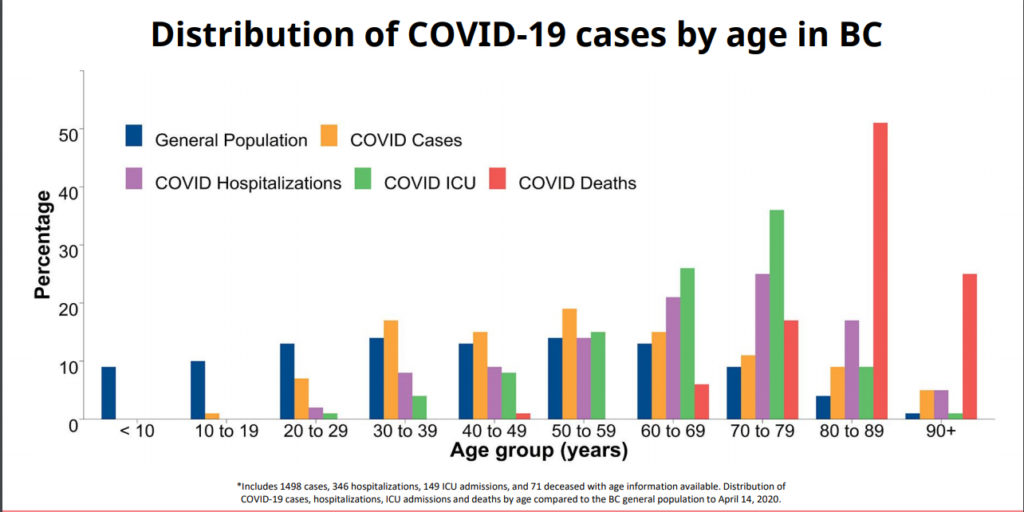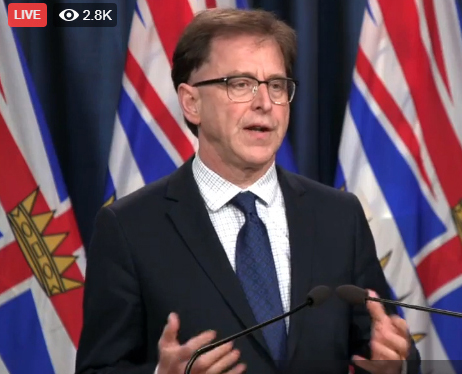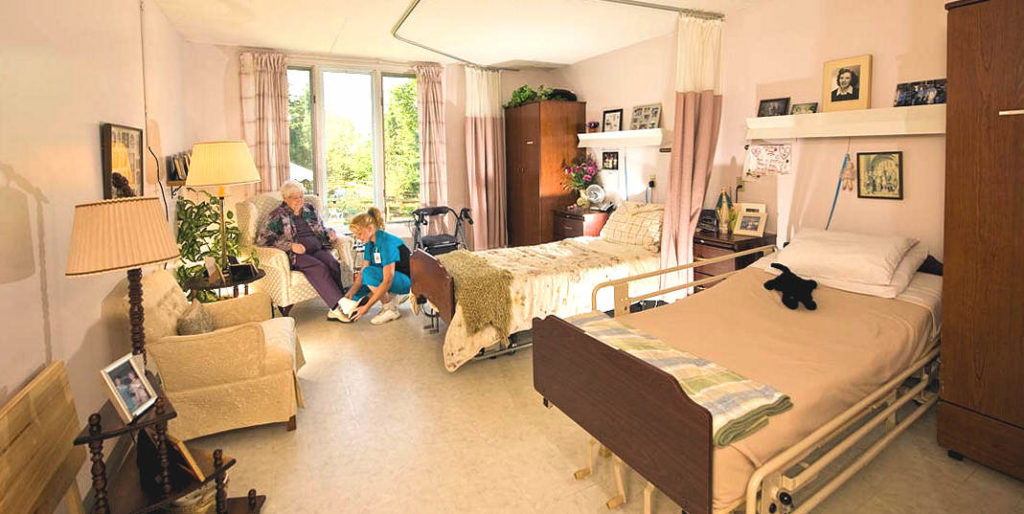
Monday April 20, 2020 ~ BC
by John Twigg ~ Special for West Shore Voice News
One of the many side effects of the COVID-19 crisis in British Columbia has been an increased focus on public policy regarding senior citizens, who so far comprise the preponderance of COVID-related deaths.
The COVID-19 data posted by the B.C. government today Monday April 20 show that overall there have been 86 deaths from amongst 1,699 cases of COVID-19 in this province (a five percent death rate). Compared to the death tally in other provinces we’re faring not too badly here in BC, although every death from such an unexpected cause is a tragedy for everyone involved.

The median age of all cases (to April 14 when a modelling presentation was given on April 17 by the Provincial Health Officer) was 54, while the median age of the deaths from COVID-19 was 86. Ages of the people who died ranged from age 47 to 101.
A graphic illustration of that peculiarity (explained by the fact that many health care workers in the 20 to 40 year old age group get the disease but deaths are among their elderly clients) can be seen in a bar graph on page 7 of the B.C. government’s background data modeling document on BC’s profile and experience of the pandemic. There is a sharp spike up in the death rate among people aged 80 to 89 and another spike in age 90+.
Many of B.C.’s COVID deaths have involved people described as elderly, frail and living in long-term care facilities, some of which have been public or non-profit facilities and others which have been private-sector for-profit facilities.

In the long-term care facilities where there is under-staffing and low pay, those employment conditions can be associated with the higher rates of death, such as care aides and other workers often working part-time at more than one institution in order to build a viable income.
B.C. has been the first province in Canada to now ban home care workers from working in more than one facility after a pattern emerged in which such workers were found to have been unwittingly carrying the virus into different facilities; that package cost $10 million, an expense that Health Minister Adrian Dix described as worthwhile.
That problem reflects the larger issue of public policy, namely how should society best care for elderly people in general and for the frail elderly in particular, many of whom cannot afford to pay for the services they need in order to age gracefully and in as much comfort as possible. (A similar problem is how to deal with drug-addicted homeless people, which also is not being solved yet in B.C., but that’s an issue for another day.)

In B.C. the provision of improved services for seniors has been a mantra in partisan politics for decades. But now that the predominant bulk of baby boomers (people born approximately 1946 to 1964) are reaching well into retirement age that question of how to pay for the growing care needs of seniors is becoming more urgent. One of the hidden benefits of COVID-19 in B.C. may be a renewed focus on seniors policies the attention to which has heretofore been buried.
That increased focus on seniors policy is all the more significant because seniors collectively are still one of the largest and fastest-growing demographic groups in the province.
There are now approximately one million people in B.C. aged 65 or older, which is about 20 per cent of the total population, but experts expect that to grow to about 25 per cent by 2034 — a relatively rapid shift that will put added pressure on health and housing and other social services.
The large and growing proportion of seniors in B.C. also has political ramifications. The 65+ age group comprises what is arguably by far the largest single block of voters in the electorate — seniors tend to comprise a relatively higher proportion of voter turnout.
Of course not all seniors think and vote the same way. But as new public policy issues emerge, seniors probably will increasingly vote in similar ways to each other. In which case, any political parties that downplay seniors’ issues in the next election will do so at their own peril.

However that reality is not yet reflected in the cabinet of NDP Premier John Horgan, in which the very competent Health Minister Adrian Dix is also responsible for many seniors issues (such as financially-challenged care homes) but there is no minister responsible solely for seniors, only a Parliamentary Secretary, who at present is Courtenay-Comox NDP MLA Ronna-Rae Leonard. Leonard was appointed in February when the previous appointee Anne Kang, NDP MLA for Burnaby-Deer Lake was promoted to Minister of Citizens’ Services to replace Jinny Sims (who had to step aside due to a since-dismissed allegation of conflict of interest).
The lack of a cohesive thrust in seniors policy is not yet evident in the statements and actions of the Union of B.C. Municipalities (UBCM) at least in regard to COVID-19, which so far have focused on the financial and property tax implications of COVID-19 on local governments and lately the impacts on local small businesses (see recent UBCM news bulletin). The UBCM website on its main page offers a redirect to the Emergency Management of BC website for information on COVID-19.
But the need to pay attention to the need of seniors is being recognized by a growing group of public policy experts including Maude Barlow, Honorary Chair of the Council of Canadians, who recently issued a statement noting that humanity is facing a global crisis on a scale not seen since World War II, including elders:

“With the COVID-19 pandemic threatening the health and well-being of untold millions and an economy in free fall, we at the Council of Canadians are thinking about how we can serve the greater good at this moment,” said Barlow, asking what role the organization could play to relieve the pain people are feeling and help shape a better future.
“Our public services, social and democratic institutions have all been compromised by decades of cuts. As our economy takes a turn for the worse, there is no doubt it will be the most vulnerable members of our society – those who are poor, homeless, racialized, elderly, disabled, gig economy and front line workers – who will feel the economic and social impacts hardest,” said Barlow, correctly including the elderly in that paradigm.
“Asserting a people’s agenda now and after the COVID-19 crisis could bring about the transformative change we all want and know is possible – a far more equal society with sustainable jobs and quality public services paid for by fair taxation,” she concluded.
Unfortunately the situations facing many seniors in B.C. are poor and getting worse even though the Horgan government has been making many positive reforms, such as Dix recently cracking down on some foreign-owned private-sector care homes that allegedly had been under-staffing and under-paying staffers in some facilities on Vancouver Island (which nonetheless have experienced a relatively low level of COVID outbreaks).
Though some people and maybe even some seniors policy experts assume that CPP and OAS will take care of most seniors’ needs, especially with other augments in BC such as the SAFER rental supplement for people over age 60, the reality is that many seniors face affordability issues and also need help with transportation, housekeeping and even some food preparation.

Those types of services often were provided by B.C.’s innovative home support program (in which social workers and care aids regularly visit seniors in their homes), but that seems to have been capped or even cut back or crimped by bureaucratic rules regarding patient-lifting or the need for wheelchair access ramps — even though institutionalization as the alternative is more costly and less effective, with some care homes becoming essentially death chambers full of unhappy people waiting to die.
The condition of seniors in B.C. has been the focus of several reports by B.C. Seniors’ Advocate Isobel Mackenzie which have highlighted how B.C. has a rapidly-growing population of seniors with increasing needs for services.

In a 2019 report titled Monitoring Seniors Services 2018, Mackenzie surveyed the range of services and supports for seniors to determine whether they’re keeping pace with the demands of B.C.’s growing ranks of seniors.
Some good news is that there was an increase in the number of seniors placed in long-term care within 30 days of assessment but some families were waiting much longer and there is significant variation between health authorities.
But there was some bad news too regarding housing, writes Mackenzie: “The cost of housing is affecting seniors as the number deferring their property taxes has grown exponentially. In addition, SAFER data show that seniors who rent are having a more difficult time as more are claiming the (rent supplement) and they are receiving a higher subsidy, telling us the gap between income and rent is growing.”
The report also looked at transportation issues, citing a need for more benches at bus stops, and at Home and Community Care services, such as Adult Day Centres and home care visits, with the not-surprising conclusions that the needs for such programs are large and growing but that funding is not — something local governments and the UBCM so far have perhaps failed to push for.
So it seems the demand for seniors services is growing faster than the funding for them and that may be reflected in the much higher incidence of COVID deaths among seniors (given the proximity of seniors to their caregivers, and seniors with fellow residents, in addition to the documented intensity of the respiratory disease on older persons compared to younger healthy people).

As a recent op-ed in The Globe and Mail concluded: “A 2017 Conference Board study estimated that, to meet demand, Canada needs to nearly double the number of long-term care beds available to about 450,000 by 2035.”
With the next provincial election looming in 2021, perhaps B.C.’s political parties and other policy-oriented bodies will soon devote more attention and funding to a problem that regrettably has taken the spurt in COVID deaths to highlight.
======= About the writer:
John Twigg is an independent journalist and senior now based in Campbell River.


